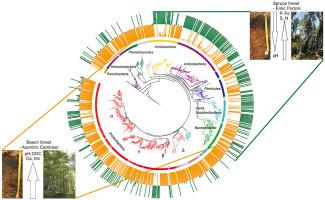European Journal of Soil Biology ( IF 4.2 ) Pub Date : 2021-01-09 , DOI: 10.1016/j.ejsobi.2020.103271 Andrea Buresova , Vaclav Tejnecky , Jan Kopecky , Ondrej Drabek , Pavla Madrova , Nada Rerichova , Marek Omelka , Petra Krizova , Karel Nemecek , Thomas B. Parr , Tsutomu Ohno , Marketa Sagova-Mareckova

|
Organic matter sequestration is influenced by both biotic and abiotic factors, which determine the rate of decomposition and result into distinguish soil forming processes and different humus types. Previous observations indicated that podzol soils and mor humus form typically develop under spruce forest, while under beech forest the higher mineralization rate leads to moder humus and the development of dystric cambisol. This study was designed to observe the forming of the different microbial communities participating in diverse decomposition processes reflecting the soil types developed under naturally occurring beech and artificially planted spruce forests. A litterbag experiment was performed with beech and spruce litter placed respectively to beech and spruce forests. In the beech forest, the observed litter decomposition rate reached the exponential faze after 15 months, while in the spruce forest a steeper decrease was noted only 29 months after the litter burial. Thus, the study focused on the period between 15 and 29 months to observe the exponential stages of recalcitrant organic matter transformation. In this period, the chemical composition of two litters was distinguished by higher contents of Mn and Ca in beech and higher content of Fe, S, N and P in spruce. On top of that, the beech litter released higher amount of dissolved organic carbon and its associated bacterial community was enriched with r-selected taxa that correlated positively with organic acids and cations. In contrast, the more acidic spruce litter was dominated by K-selected acidophilic community and its turnover rate was slower, resulting in increased carbon sequestration. The higher pH and humus quality of beech cambisol also correlates with its observed higher resilience to disturbances by acidification, pests or climate change in mountainous environments.
中文翻译:

酸性森林土壤中凋落物的化学质量和细菌群落结构影响分解
螯合有机物受生物和非生物因素的影响,这些因素决定了分解的速率,并导致区分土壤形成过程和腐殖质类型。先前的观察结果表明,云杉林下通常发育荚果土壤和腐殖质形式,而山毛榉林下较高的矿化率导致腐殖质变质和异丁二酚的发展。本研究旨在观察参与不同分解过程的不同微生物群落的形成,这些分解过程反映了自然形成的山毛榉和人工种植的云杉林下土壤类型的发展。在山毛榉和云杉林分别放置了山毛榉和云杉凋落物的情况下进行了垃圾袋实验。在山毛榉森林里 15个月后,观察到的凋落物分解速率达到了指数级的高峰,而在云杉林中,仅在凋落物埋葬后仅29个月,观察到的分解率急剧下降。因此,该研究集中在15到29个月之间,以观察顽固有机物转化的指数阶段。在此期间,两个垃圾的化学成分以山毛榉中Mn和Ca含量较高,云杉中Fe,S,N和P含量较高为特征。最重要的是,山毛榉凋落物释放出更多的溶解有机碳,并且其相关的细菌群落富含与有机酸和阳离子呈正相关的r选择单元。相比之下,酸度较高的云杉凋落物主要由K选择的嗜酸菌群落主导,其周转速度较慢,导致碳固存增加。山毛榉三醇的较高的pH值和腐殖质的质量还与其在山区环境中对酸化,害虫或气候变化造成的干扰的较高复原力相关。

























 京公网安备 11010802027423号
京公网安备 11010802027423号